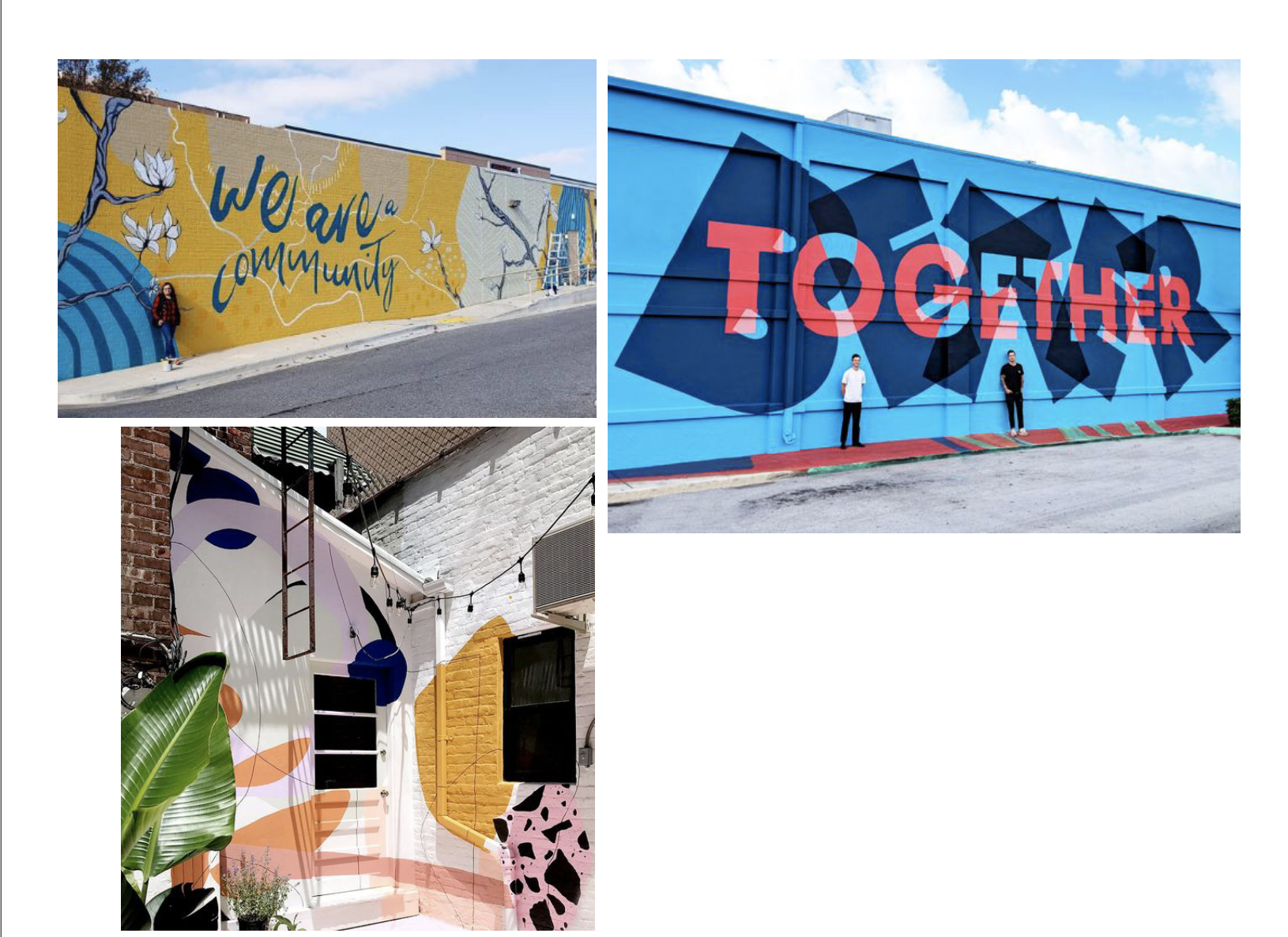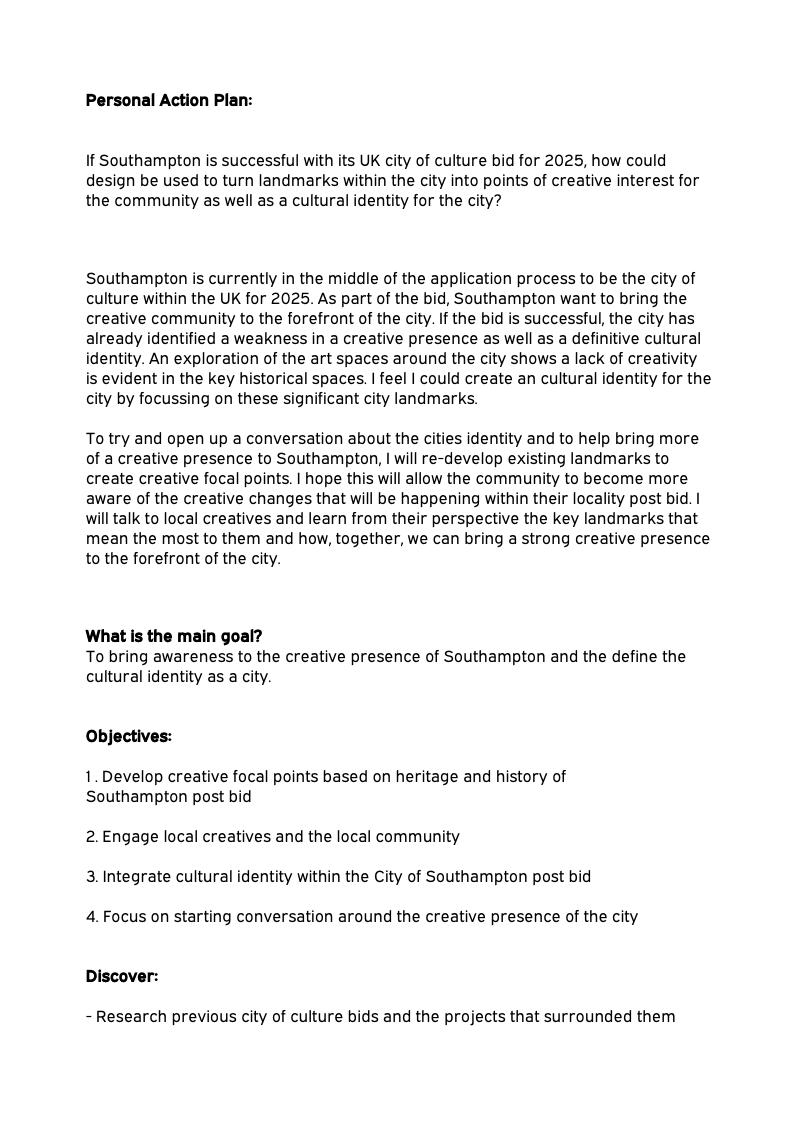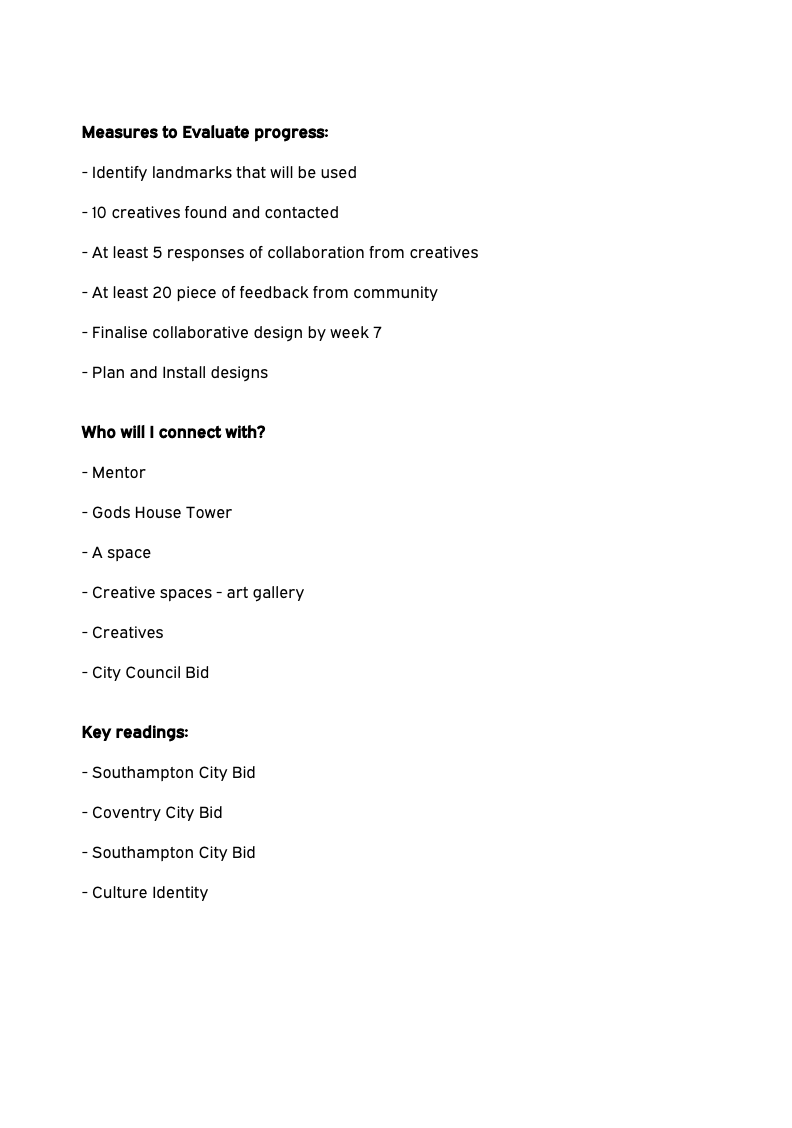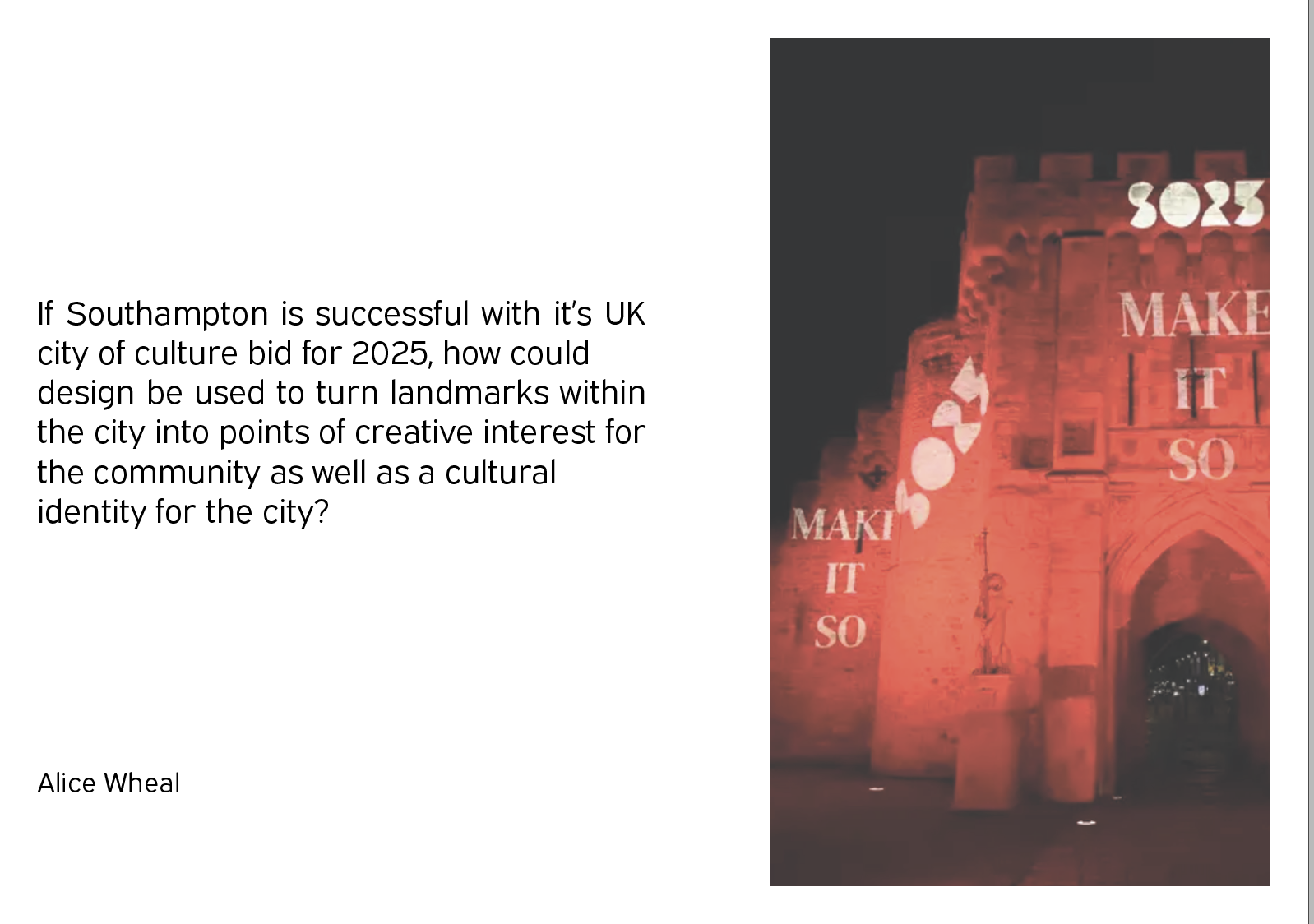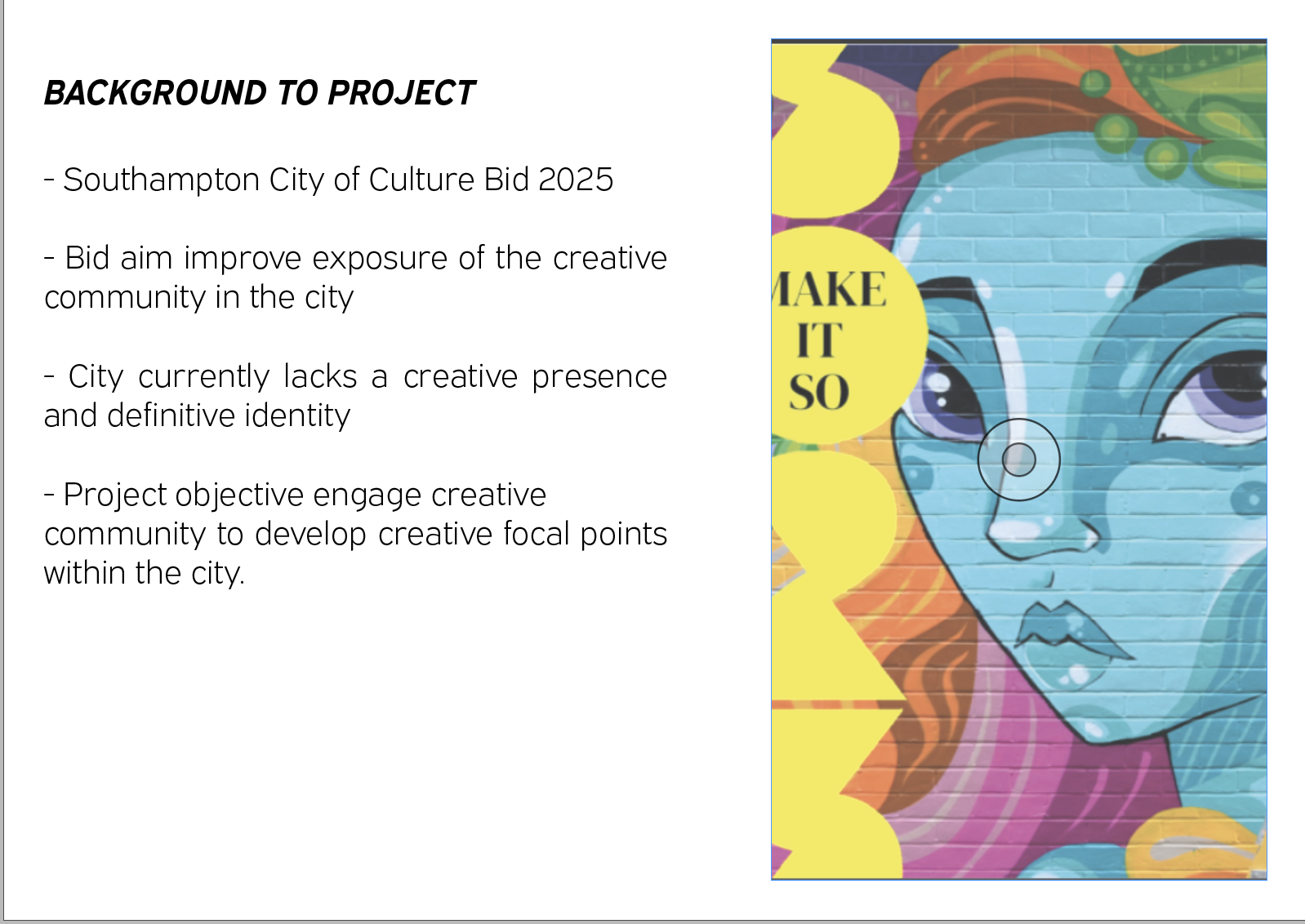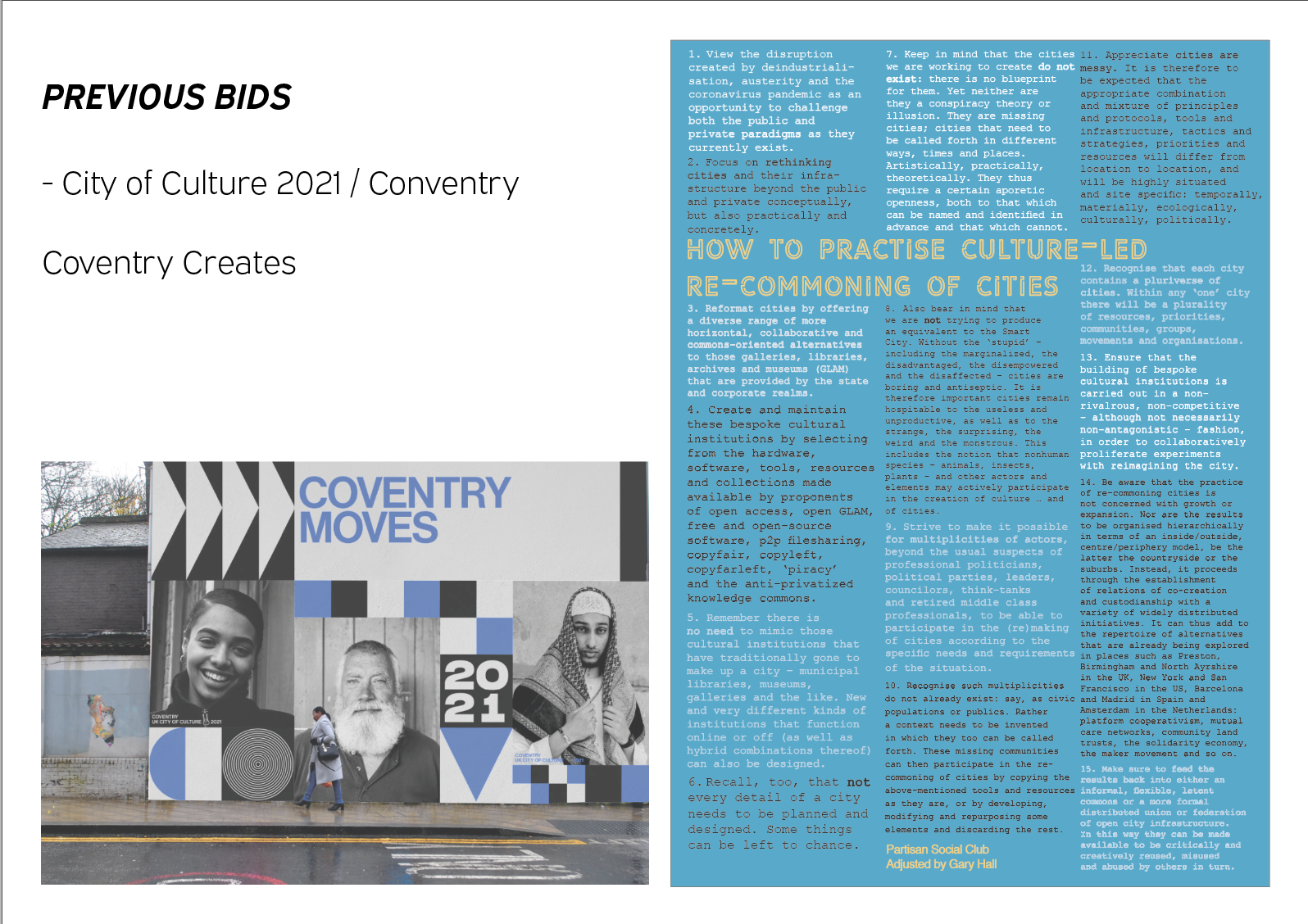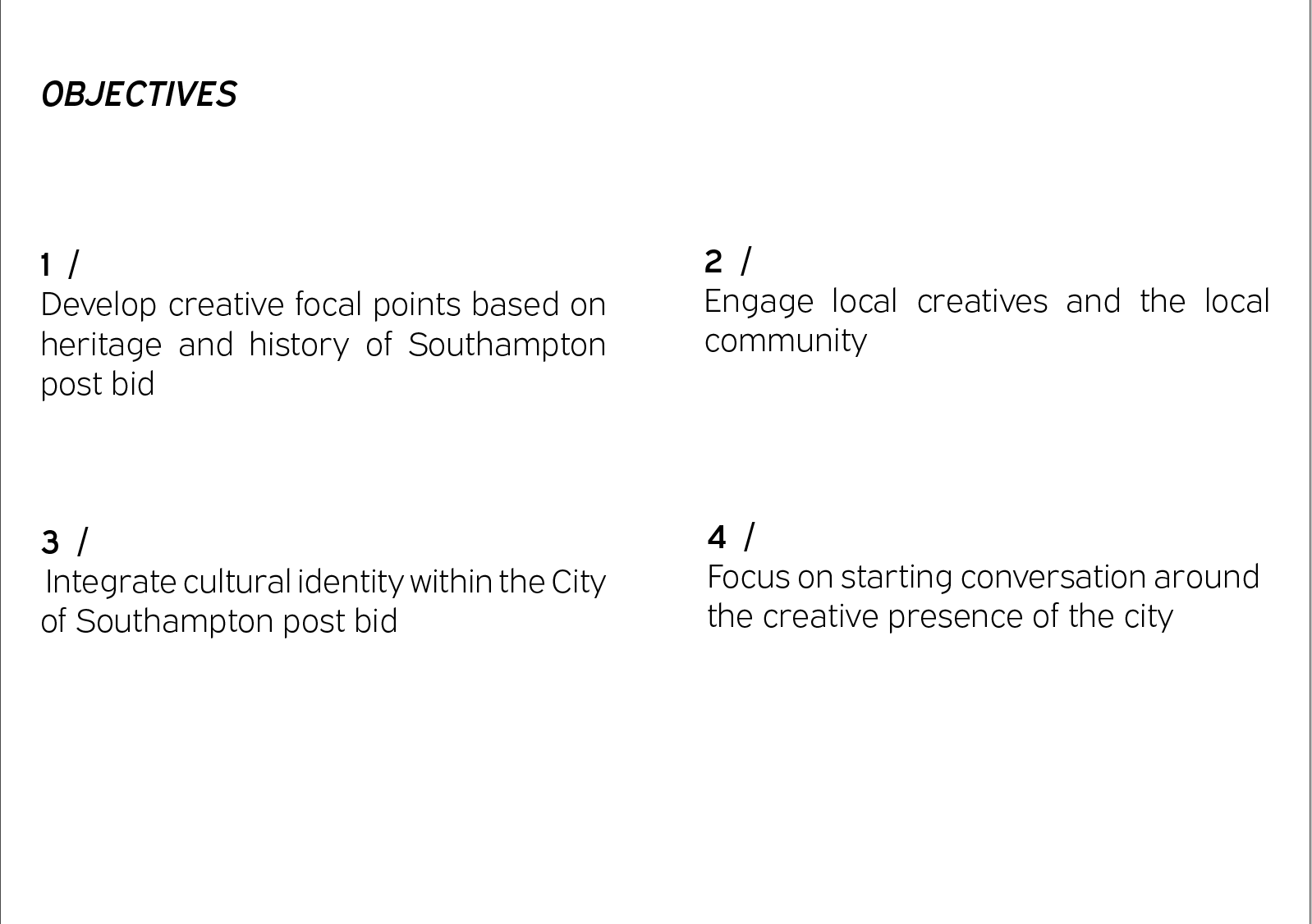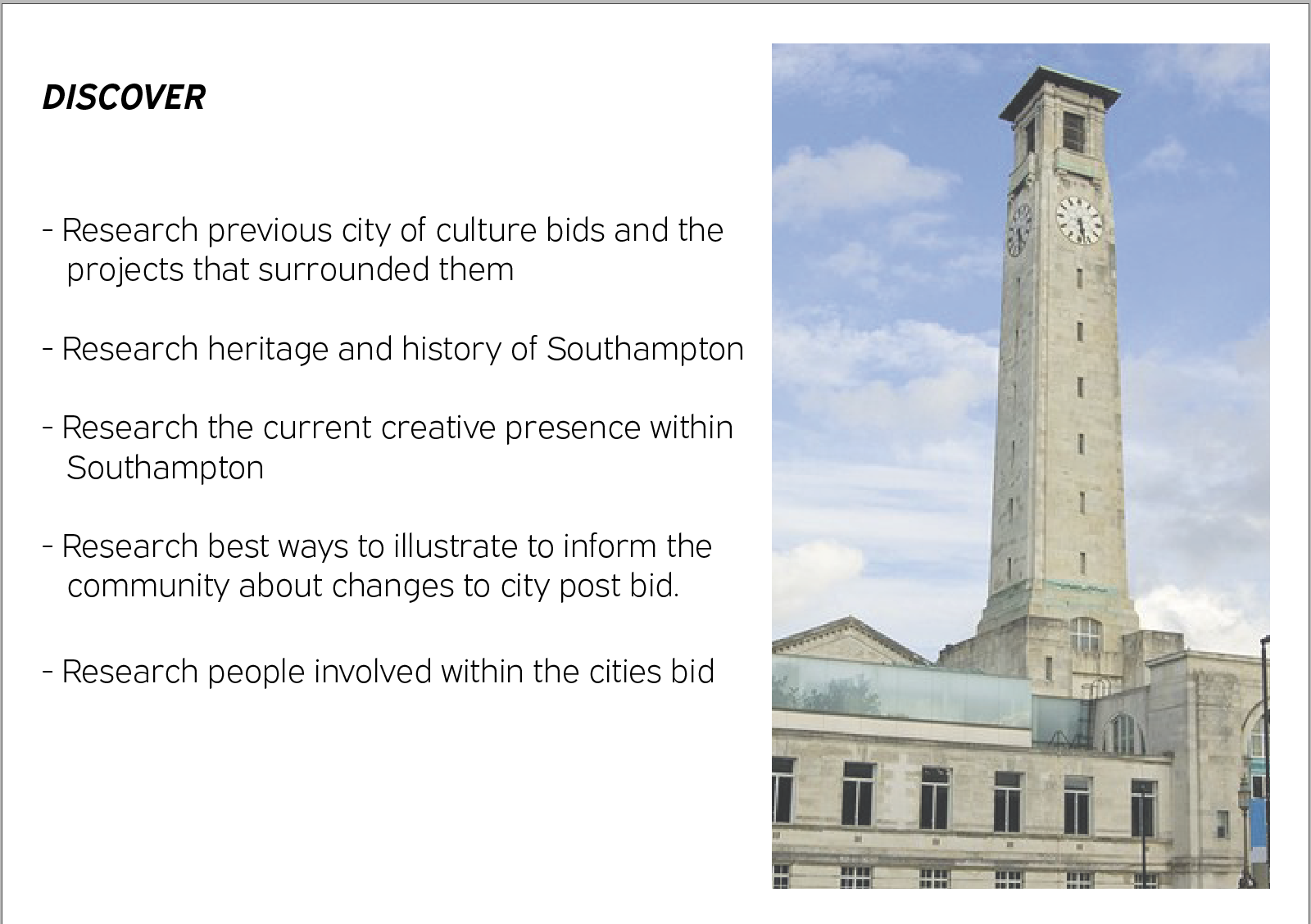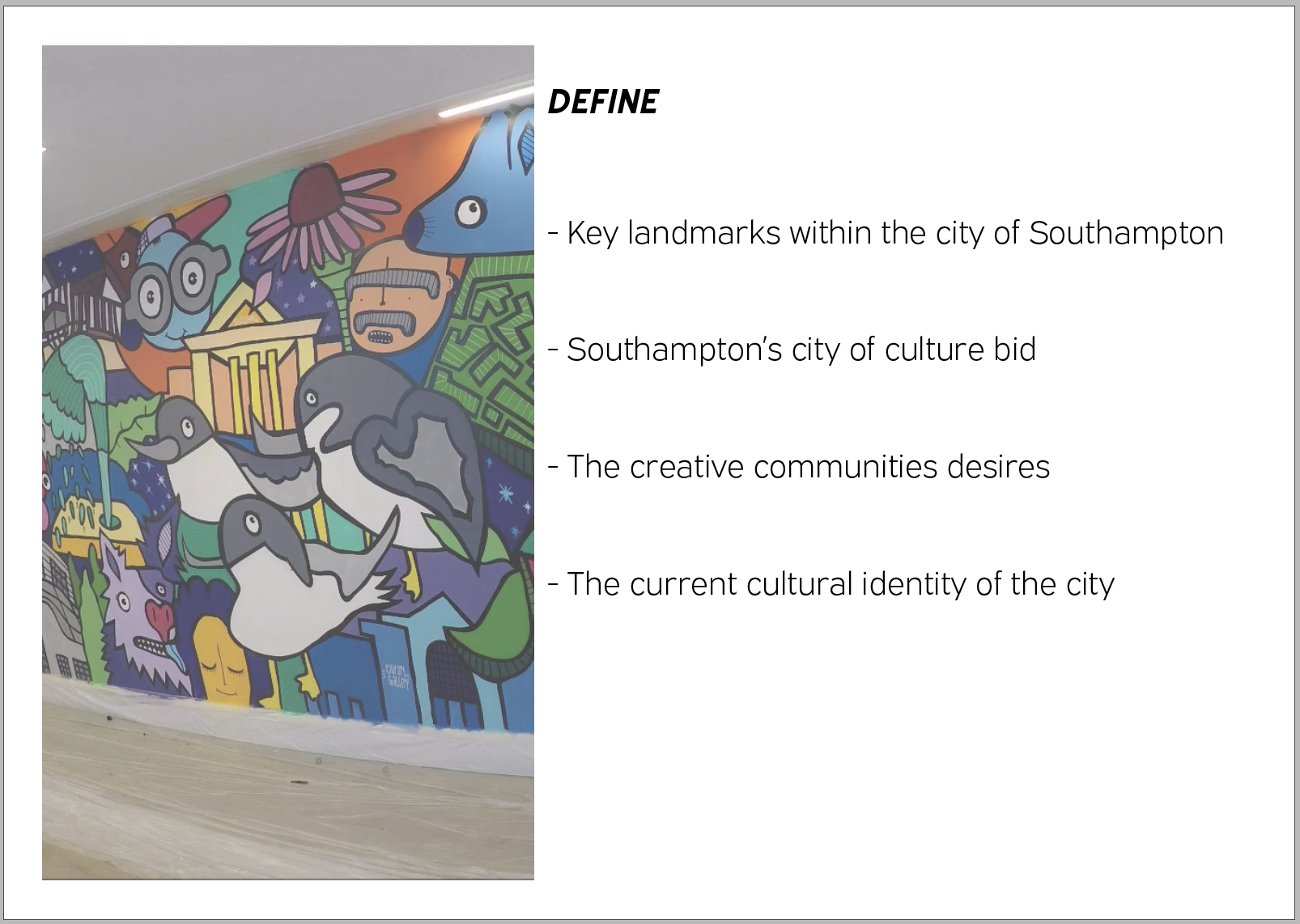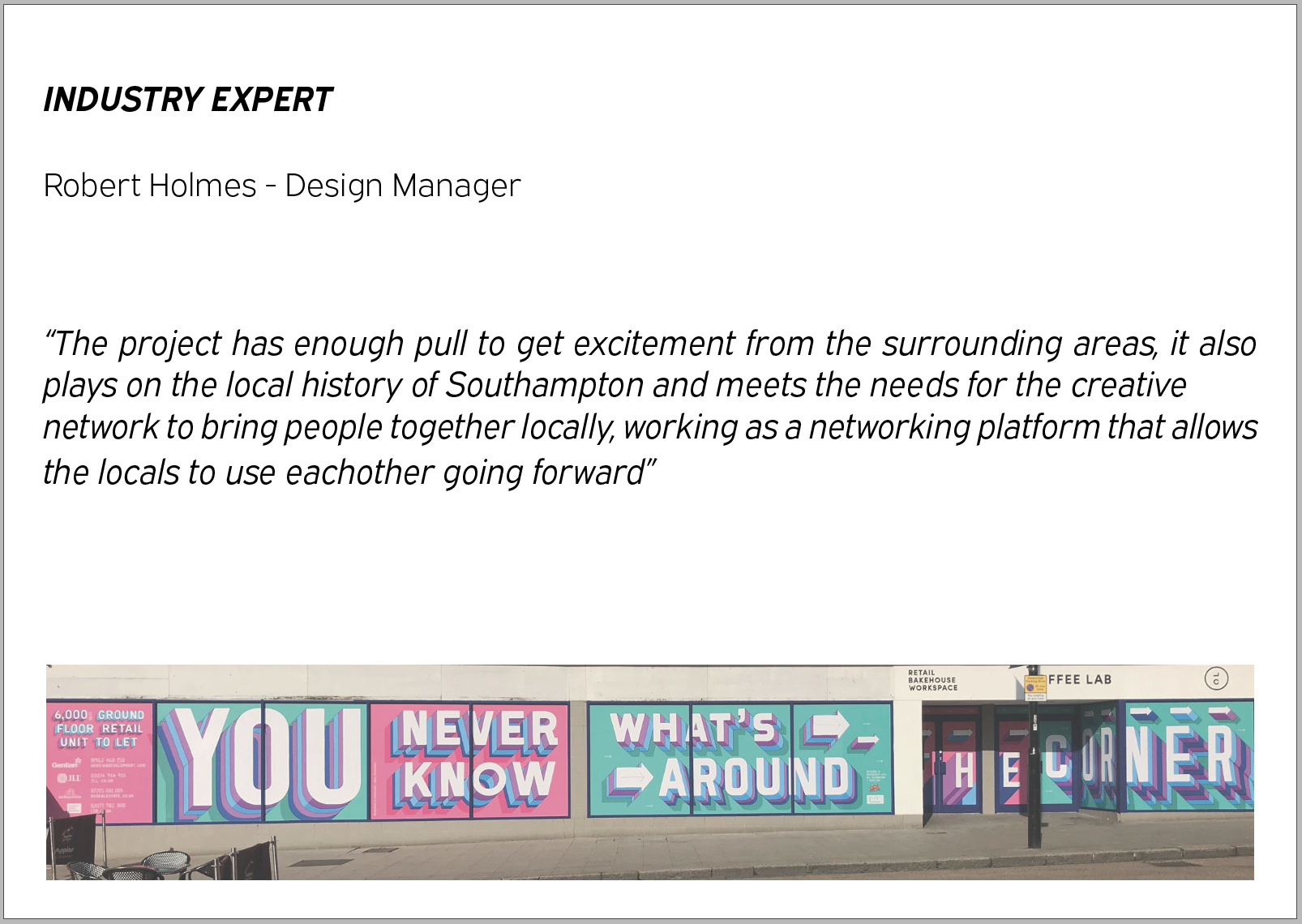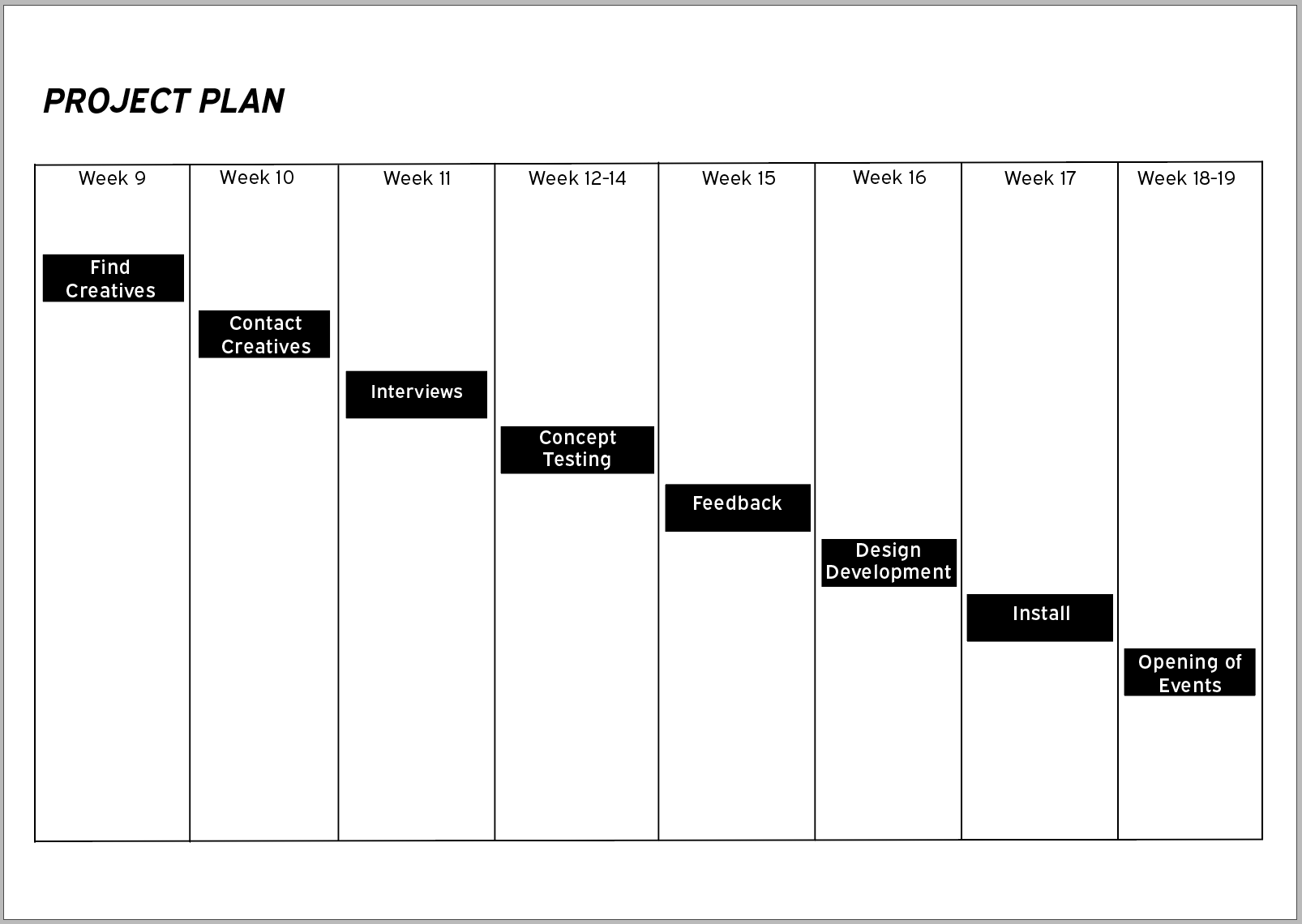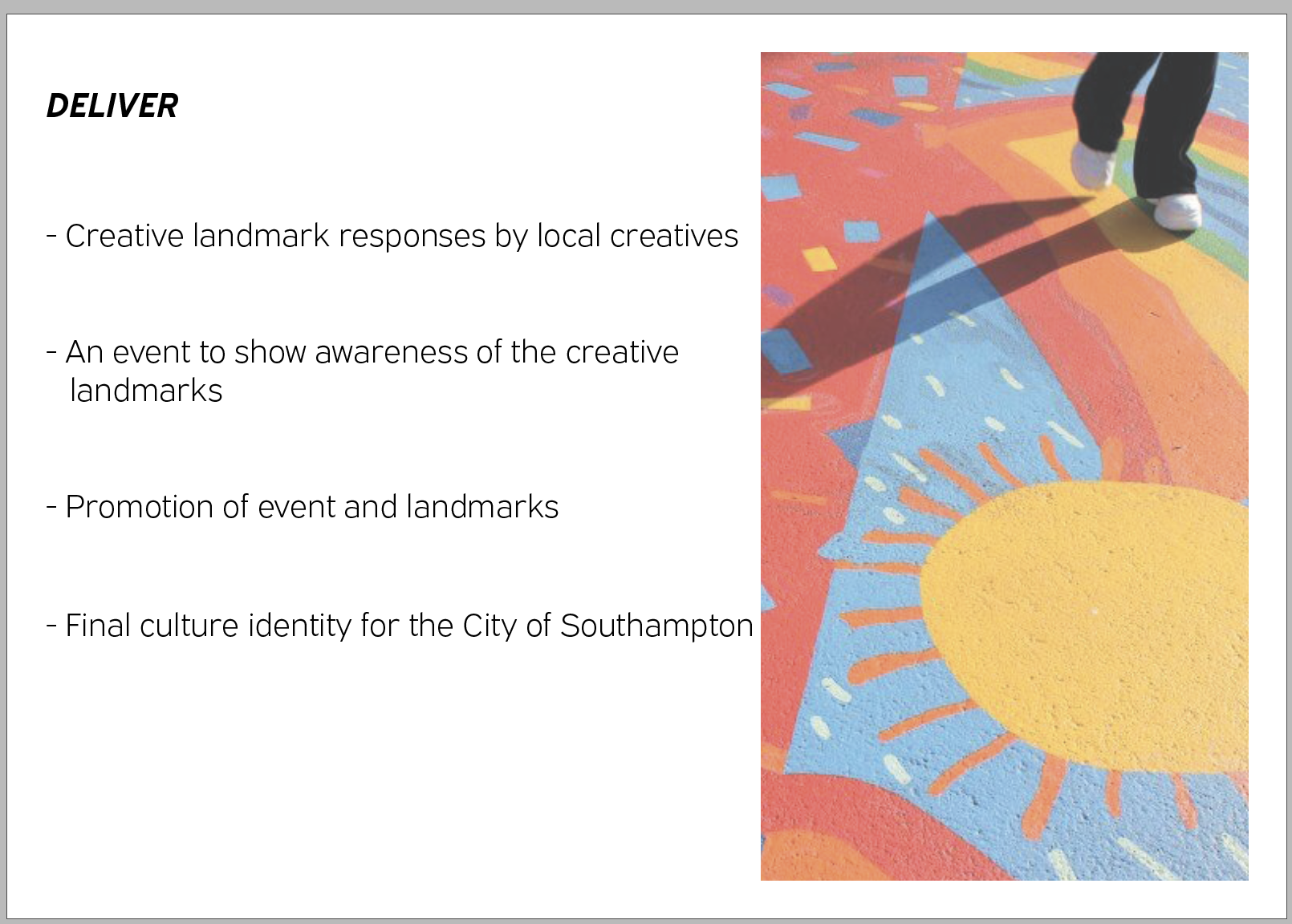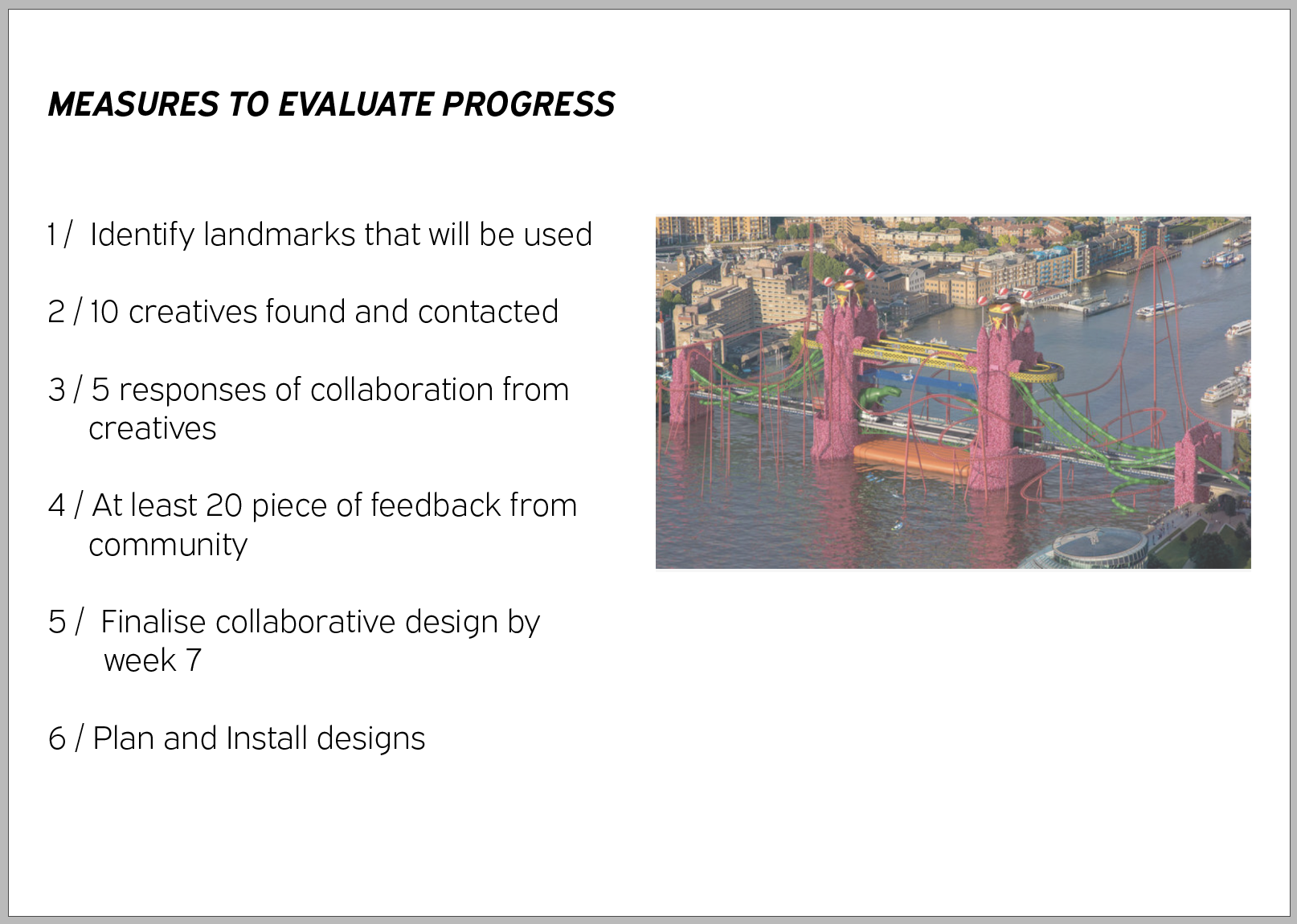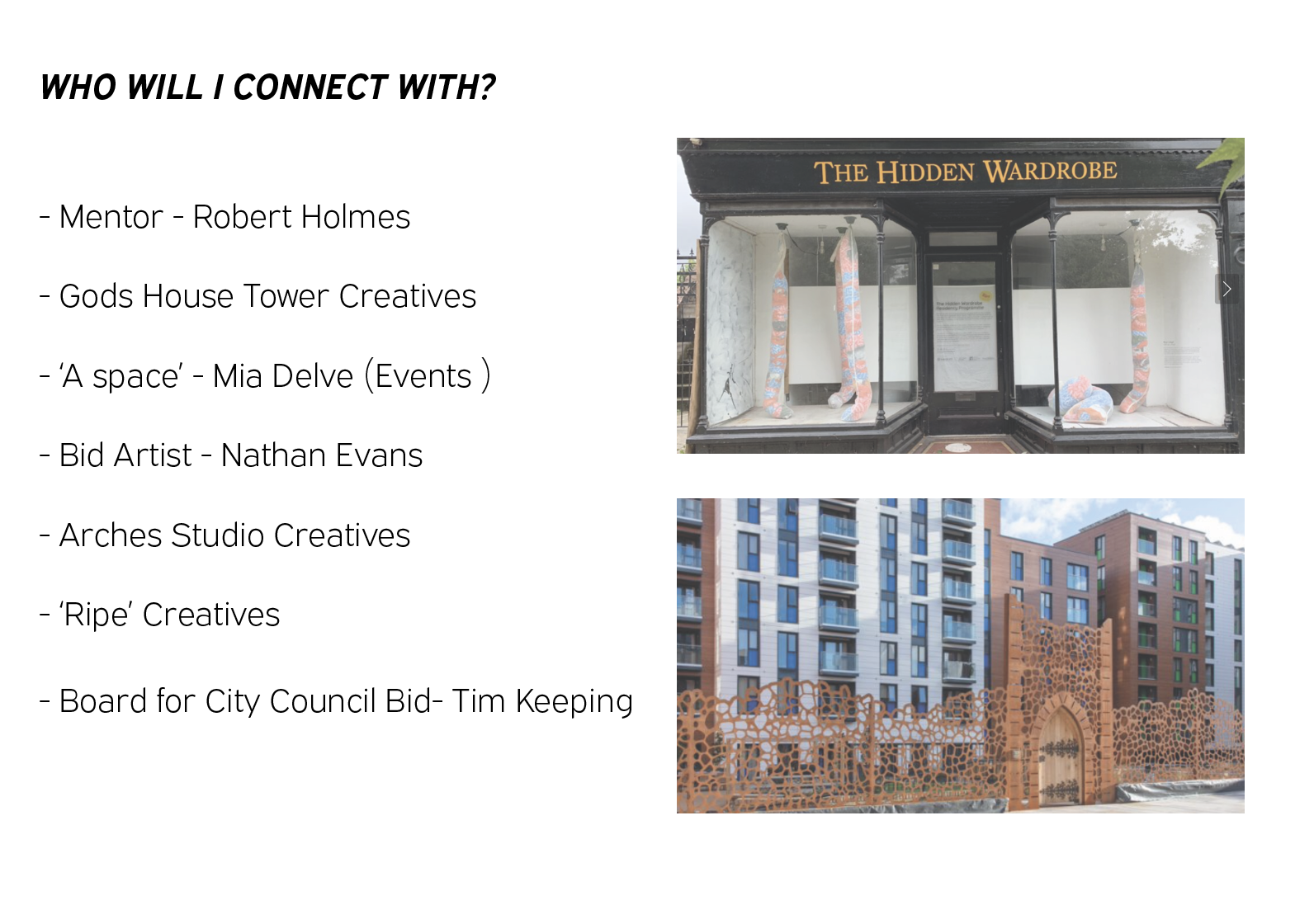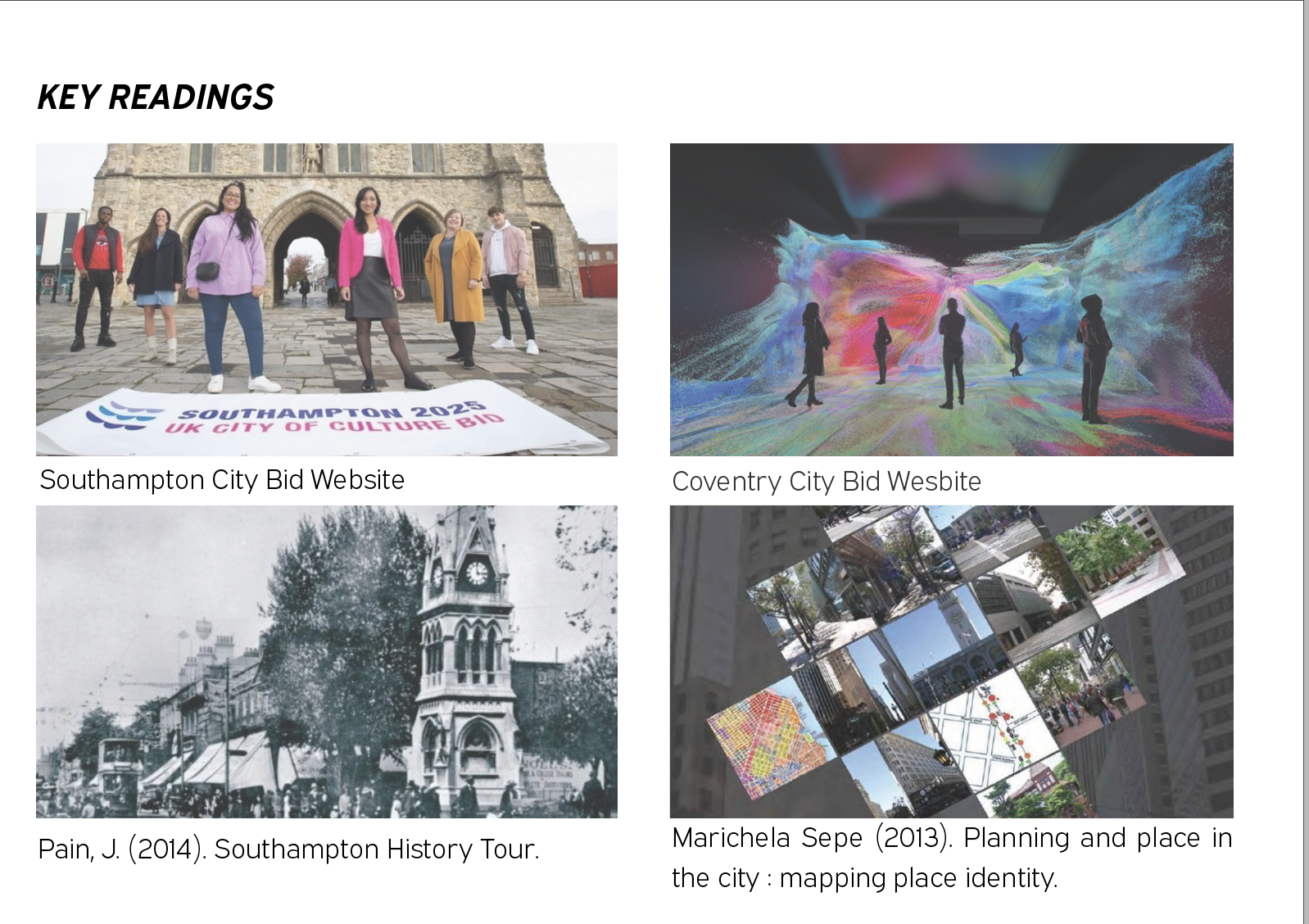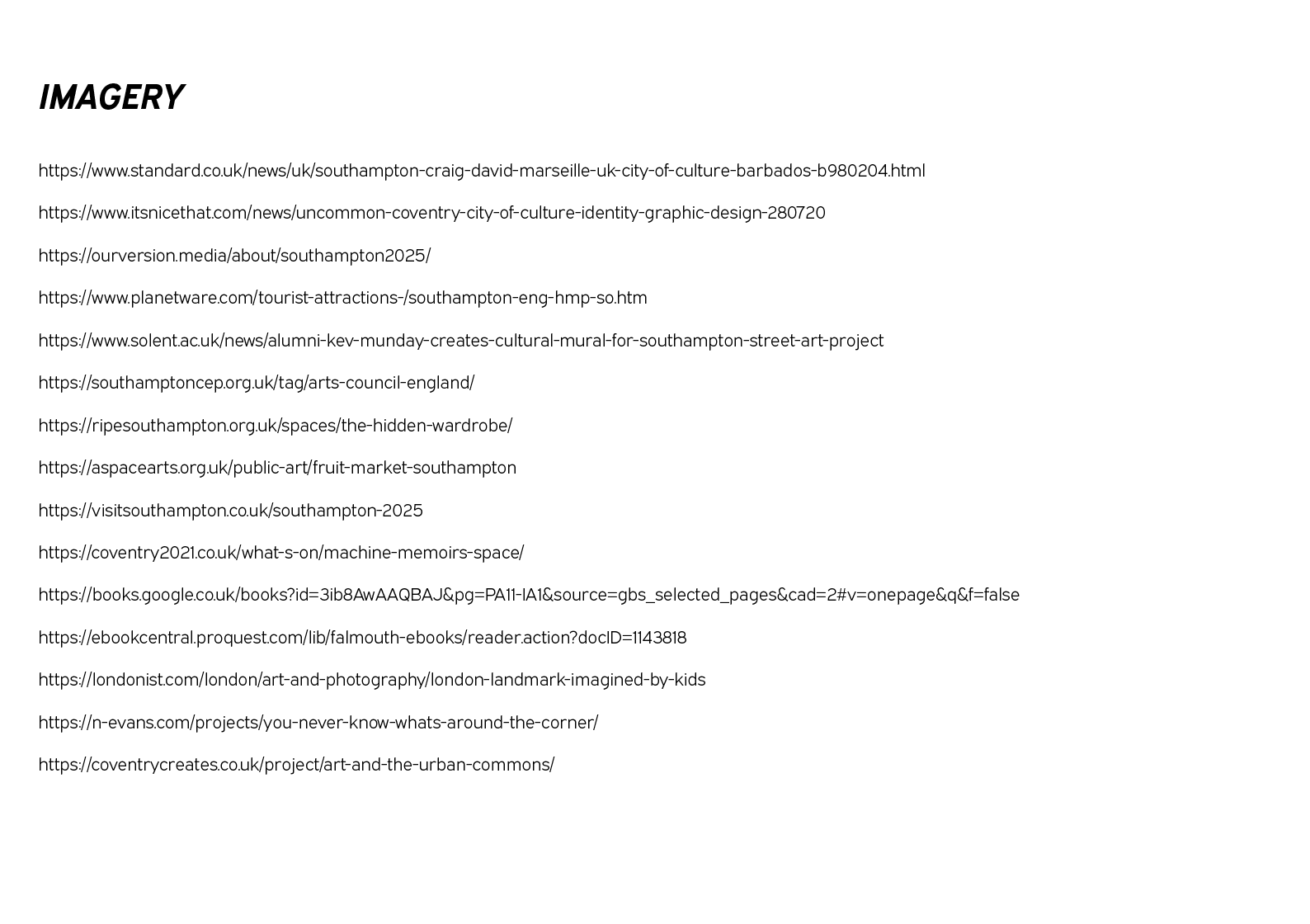Phase 2 - Week Seven + Eight
As both these weeks, I would be working forward on creating the presentation for the panel review, I decided to merge the weeks together.
Week 7
Within this week I also wanted to focus on ideation surrounding my project and starting to test some ideas and talk to other designers:
Peer to Peer Week Seven
Within the Peer to Peer this week, it was really great to speak through my ideas with Lizzie, who even mentioned having contacts within the Southampton City Council. Although the peer to peer didn’t give me any other ideas to do with my project, it was great to talk through my project where Lizzie has experience with Southampton and a vague idea what it needs as a city. She also mentioned some contacts that might be able to help me progressing forward with my project.
Case Study
Since changing the topic / subject of my research question, I wanted to do some more research on landmarks and creating an identity as well as artist input:
https://www.itsnicethat.com/news/uncommon-coventry-city-of-culture-identity-graphic-design-280720
I looked up this previous city of culture identity which references the city’s brutalist history which I thought was interesting. It was designed by uncommon, which has applied a modular design identity that comes to live in motion graphics. The article perfectly explains about the identity of the project, “The geometric motifs draw from Coventry’s architecture. The city was devastated by bombing during the Second World War and saw a huge rebuild afterwards, making its architecture largely modernist and brutalist in style. Uncommon’s identity embraces this, not just by visually referencing its buildings but also its spirit of movement and growth, the graphics sliding and spinning over the top of photos of residents, hoping to pay tribute to its people, cultures and history. Among the brand elements is also an icon of Coventry’s famous cathedral, and its elephant – a centuries-old symbol of the city from its official crest.
Look further and even the strong blue colour chosen to dominate the identity has its roots in the city’s heritage. Working with museum The Weaver’s House, the team explored the city’s medieval past as a centre of the UK’s textile industry, and found a colour first used in Coventry and now seen across the city: Coventry Blue. The brand uses a “modern-day standard” of the hue, called Moving Blue“.
I feel this project directly relates to what I hope to do within the city of Southampton post bid win, look at the key heritage and history of the city and encourage artists to help me to create the identity thats consistant with the new culture intentions that the city has. It was interesting to read about the certain decisions that were made across the project, especially the people that were chosen and the colours were used in order to create this identity.
Continuing my research on identity creation across cities, I found this case study that looked at the new logo that was created for Los Angeles tourism. Within this project they have reimagined the creative expression of Los Angeles as a collaboration between Shepard Fairey and Andy Cruz. A quote from Fairey that really explained why they were doing this was the following; “When you say ‘Los Angeles’ it doesn’t necessarily mean just a city. It’s a whole mindset, a vibe, a culture, and as an Angeleno, it was exciting to me to take on the creative challenge of designing a mark representing all of the things that Los Angeles means to people,” says Shepard. “On that creative path, I worked with my team at Studio Number One, and the inspiring cool factory that is House Industries led by my friend Andy Cruz. We all dug deep into L.A. culture and came up with a great solution that we feel embraces the spirit and optimism of L.A”.
The main inspiration for the colours show the colours above the sky within the city, with the logo overall capturing LA’s '“vibrant history, diversity, culture and lifestyle”, as well as the “optimistic spirit of Angelenos”. Again there was also a huge focus on the architecture and the iconic things that make the city what it is.
Another interesting brand identity created to launch the reopening of LA after the pandemic, I think the identity concept is a good idea and seems to be very similar to the ideas of the coventry city of culture case study but as a design perspective I am not sure the colour wave is working for them and feels very touristy which could be the reason why they used it in the first place.
I used this case study last week to take some images from, But I love the concept that the article talks about which is the annual public art event that takes place next to the iconic architecture landmarks. The director talks about the event as the following: “ Iwona Blazwick, Director of the Whitechapel Gallery, said: "Sculpture in the City takes us on a cultural safari through the medieval lanes and postmodern plazas of the City of London to encounter some of the most exciting public art being made in the world today."“
Some interesting art responses have been given as well as this you are able to take family friendly tours and trails and take part in activities exploring the sculpture and the architectural design. I like that this event allows for artists to join in with some of the city sculptures and they are able to be exposed on a public level I also think its a great idea to have something along side the sculptures that encourages the public to take part.
https://www.creativeboom.com/inspiration/creative-cities-cardiff/
I wanted to include this example from Creative Boom who have done inspiration for the cultural spaces that are a must whilst you are visiting the city of cardiff. They have done this for a lot of the cities across the UK and I think it’s a great way to show case the things that are going on within the city and the things that you can note for when you do visit.
Another article that looks at the landmarks is this one by the Illuminated River Foundation on Design week. They invited designers a couple of years ago to do permanent light installations on London Bridges. So as part of that, Design week asked other designers what landmarks they would like to redesign / make over. I have quoted a couple of my favourite below:
Sam Bompass, Bompass and Parr - “As I walk through the city with my co-founder Harry, we often speculate on what certain landmarks would taste like – the caramel wafer confection of the Houses of Parliament set against the iced mint twister of the Gherkin.
For us the landmarks that should be brought to life by designers are the overlooked statuary of the city. London’s many thousands of statues, memorials, sculptures and public landmarks each with many stories. One of my favourites is the Monument to the Unknown Construction Worker by the Tower of London. Perhaps designers could bring the life force back into this overlooked street embellishment, making statue viewing a craze that sweeps the nation.
For ourselves we’d create cocktails that paired with the different monuments, both flavourwise and in terms of stories. Then for a day each year we’d invite everyone to come do bodyshots off their favourite statues.”
Luke Thompson, designer, Kin Design - “The success of light based festivals like Lumiere really show not just the appetite for immersive and impressive installation pieces, but also prove that there’s an engaged audience in cities at night. I think it’d be great to use some of our amazing museums to showcase choice archive objects on the outside of their buildings after hours. Even the post pub crowd around Bloomsbury could soak up some British Museum highlights.”
I really like the creativity that always comes from Bompass and Parr and the out of the box thinking. I love how Bompass talks about the stories that buildings and places have and how they could be created into matching cocktails which is the definition of story telling. Im also intrigued by the works of Thompson who focussed more on the immersion of the installation and how the audience would engage which is obviously at the front of the minds of designers.
https://www.designweek.co.uk/unboxed-festival-launches/
I have briefly touched on the Unboxed festival before in a previous case study analysis. I connect with what their essense of the festival which is to “showcase “creativity at the heart of the everyday””. They have released information that looks at what they are doing over 2022, which involves engaging more than 600 creatives, creating jobs and opportunities for creatives in the UK. 10 Final projects have been shortlisted, two of my favourite short listed projects from the selection are the following: Green Space Dark Skies and A visualisation of Tour de Moon’s convoy.
Green Space Dark Skies:
This project which can be seen in the image above is, ‘One of the most ambitious projects of the festival comes from a collaboration between outdoor arts group Walk the Plank and technology company Siemens”. This will engage 20,000 participants across the UK who are known as the Luminators, who will be recruited from local communities to make moving pictures across the landscape.
A visualisation of Tour de Moon’s convoy:
ANother project is this one which is a 10km sculpture trail. It will be a scale model of the solar system and have an interactive app that allows learning and events. All the work that will be done will be in collaboration with the moon.
Both these concepts are really creative way of engaging the local community with art and something fun and interesting for all ages and even families. I think one of the main points behind the green space dark skies, links to the lack of lighting that green spaces have which can often view them as being dangerous. I fully support these projects and can’t wait to see the after images.
Finally within this case study analysis, I found this article which was really interesting when looking at the city’s cultural identity. The article talks about how to understand the cultural identity of the city, often taking shape on the public spaces. There are also points that are made by how important it is to have artists contribute to the identity of the city, “The combination of different characteristics and quirks within a city is crucial to creating a positive, and economically prosperous, identity.”
Another crucial point that was made was looking at the smaller projects, which is where the citys cultural identity can be found but its made clear that its not in one place its everywhere.
“Often these are grassroots ventures, powered by the passion of those driven to engage. Street art, community enterprises and cooperatives, or the simple joy of coming together and creating something meaningful or fun. It brings connection and belonging. Artistic or cultural output can help to create a sense of place and support the building of relationships. Projects can also cut across community boundaries and encourage cohesion and authentic human attachment. Those smaller stories soon add up to a fascinating and varied ongoing conversation across the city.”
This article really highlights the key points that I am trying to get across within my research question, trying to highlight the key areas of the identity within the city. I think starting a small project like my research question could bring together people and create connections and quirky creative interests that would allow for conversation and community connection. I love how this is written so well and seems like the perfect thing to be doing within Southampton who seem to still be looking for an identity as a city.
Ideation
I decided to do a mind-map of all the things that I had looked at so far with my project.
This then allowed me to collate 4 different idea areas and curate 4 different moodboards:
I selected 4 different words from the mood-board which were sculpture, murals, Spaces and regeneration. This created 4 different ways of looking at words associated to my project:
Sculpture:
https://www.pinterest.co.uk/pin/23995810504969052/
https://www.pinterest.co.uk/pin/350225308532673097/
https://www.pinterest.co.uk/pin/255368241359606887/
https://www.pinterest.co.uk/pin/2533343519627317/
https://www.pinterest.co.uk/pin/679691768737164910/
https://www.pinterest.co.uk/pin/3448137204035043/
Mural:
https://www.pinterest.co.uk/pin/849350810984623943/
https://www.pinterest.co.uk/pin/355291858099262759/
https://www.pinterest.co.uk/pin/508906826648817465/
https://www.pinterest.co.uk/pin/356488126764220412/
This may seem like all these images have nothing related to my project, but I wanted to have some sort of work associated to them and try to not keep a closed mind of the outcomes that would be available for me to produce.
Presentation:
These are the following things that are needed for the panel review so I need to make sure that I complete all of these areas before the review;
1 A well defined research question and paragraph project description
2. tasks that can be carried out to complete your project
3. Project lead / collaborators / contributors
4. when will these tasks be completed
5. Resources needed to complete the tasks
6. Measures to evaluate progress
Week 8
Within this week I also wanted to focus on the project plan that needs to be refined:
Industry Professional Presentation and Feedback
Design Studio
Notes from my Industry Specialist chat with Robert Holmes who runs some of the Adidas contracts for the stores within UK.
Robert and I spoke about him becoming my mentor for this project as well as what he thought about my current research question. I have taken some notes but he was also going to email me some feedback over the next couple of days, the quotes are as follows if the feedback doesn’t arrive in time for the presentation;
“The project has enough pull to get excitement from the surrounding areas, it also plays on the local history of Southampton and meets the needs for the creative network to bring people together locally”
“There is a need for the creative network to bring people locally”
“Creative people projects produce everything from illustrations to other people networking platform, use each other going forward”
Rob also sent me an email with some quotes from out meeting ;
“As a Designer living in the Southampton area for over 15 years I would very much welcome the prospect of Southampton becoming the UK City of Culture 2025. As well as bringing investment into the city I feel there is so much potential creative talent within the area which would gain invaluable exposure on the back of the positivity and energy created by a successful bid.
Having moved down from London and now living and working locally to Southampton I have found it a real challenge to build a network of local Designers, Photographers and Artists.
I feel there is a huge potential and appetite for a creative hub/community within Southampton to enable fellow creatives to collaborate and utilise local talent. If successful in its bid for City of Culture 2025 this could potentially be the catalyst that helps build this community. “
City Council
I previous spoke to Lizzie last week about getting in contact with a person that is on the Bid for the city of culture as this would give me valuable advice about my project, unfortunately he did not respond in time to gain valuable feedback for the presentation. I will continue to try to get in contact but this has led me to creating a spreadsheet with all the contacts in for the project which I have listed below;
Formative Assessment Outputs
Personal Action Plan
To start getting together the information for the presentation, I created a document where I could write out what I thought needed to go within it. I did previously make a project plan but i feel my project has moved on since I previously created this. Then I can take that and pair the words with images and bullet points taken from my work. Through this development, I referred back too; Peter Phillips; Creating the perfect design brief: how to manage design for strategic as well as the Double Diamond approach:
Once this was written out in brief format, I was able to take the points and place them within the presentation:
Literature review and Bibliography
Southampton’s City Bid
Principle of the bid:
https://www.southampton.ac.uk/community/ukcityofculture2025bid.page
City of Culture Bid’s
https://www.britishcouncil.org/research-policy-insight/insight-articles/city-culture-reflects
Previous City of Culture Bid’s
https://www.itsnicethat.com/news/uncommon-coventry-city-of-culture-identity-graphic-design-280720
https://www.business-live.co.uk/economic-development/uk-city-culture-everything-you-21361789
Cultural Identity
https://www.peterlang.com/document/1043853
https://escholarship.org/uc/item/98t7w9kx
Landmarks in Southampton
https://visitsouthampton.co.uk/blog/10-must-see-landmarks-to-unearth-southamptons-history
https://www.dailyecho.co.uk/news/19679570.landmarks-southampton-see-important/
Report Outline Refined
I redefined the report that we were given feedback on that would co-respond to the changes that I have made over the past 8 weeks.
Contacts
I decided to create a spreadsheet that would allow me to keep all the contacts in one place. This will updated in the future to say whether I have contacted them and whether I have had a response too:
It is pretty empty at the moment, but hoping within the future weeks it will be filled with contacts that I have connected with.
Peer to Peer Feedback
Within the Peer to Peer session this week, I was hoping to run through the presentations at the stages that they currently are before the pitch. I always find this really helpful to talk to others who are in the same position but to also understand what they are doing and why, which allows me to reflect on my own work, but unfortunately no one showed up to the peer to peer which I organised this week.
Weekly Summary
Week 7:
Week 7 allowed me to explore different case studies that had different approaches to a similar theme of projects. This allowed me to consider my research question further and thinking to the end of the project when having to come up with a final design. I have come to realise that identity creation comes from many different places and takes inspiration from many different influences, I feel this is something I really need to consider within my question.
Week 8:
This week was mainly focussing on getting everything together for the review, I created an outline of what I thought needed to be in the review but I ended up being fairly disappointed with the response to my project. I think this might just be the way I worded the project or what I focussed on within the presentation. This will be something that I need to summaries and make a action plan for next week to consider how to explain what I want to do in a more considerate and thought out way.
Resources
Baker, T. (2018). Sculpture in the City: Artworks in London’s Square Mile alongside the city’s historic landmarks. [online] Creative Boom. Available at: https://www.creativeboom.com/inspiration/sculpture-in-the-city-artworks-in-londons-square-mile-alongside-the-citys-historic-landmarks/.
Cale, A. (n.d.). Consuming Culture: The heart of the city’s cultural identity is not in one place, it’s everywhere. [online] The State Of The Arts. Available at: https://www.thestateofthearts.co.uk/features/consuming-culture-the-heart-of-the-citys-cultural-identity-is-not-in-one-place-it-is-everywhere/ [Accessed 17 Jun. 2022].
Cowan (2013). A creative’s guide to Cardiff: Waterfront living and plenty of culture in Wales’ capital city. [online] Creative Boom. Available at: https://www.creativeboom.com/inspiration/creative-cities-cardiff/ [Accessed 17 Jun. 2022].
Long, M. (2021). Unboxed Festival plans to showcase ‘creativity at the heart of the everyday’. [online] Design Week. Available at: https://www.designweek.co.uk/unboxed-festival-launches/ [Accessed 17 Jun. 2022].
Maher, D. (2021). As the city reopens, Shepard Fairey and Andy Cruz collaborate on a new logo for Los Angeles Tourism. [online] www.itsnicethat.com. Available at: https://www.itsnicethat.com/news/shepard-fairey-andy-cruz-studio-number-one-house-industries-los-angeles-tourism-graphic-design-070721 [Accessed 17 Jun. 2022].
Marichela Sepe (2013). Planning and place in the city : mapping place identity. London ; New York: Routledge, Taylor & Francis Group.
McLaughlin, A. (2016). Designers tell us which landmarks they would like to see brought to life. [online] Design Week. Available at: https://www.designweek.co.uk/issues/6-june-12-june-2016/designers-tell-us-landmarks-like-see-brought-life/ [Accessed 17 Jun. 2022].
Pain, J. (2014). Southampton History Tour. [online] Google Books. Amberley Publishing Limited. Available at: https://books.google.co.uk/books?id=3ib8AwAAQBAJ&pg=PA11-IA1&source=gbs_selected_pages&cad=2#v=onepage&q&f=false [Accessed 18 Mar. 2022].
Things to remember
What do you do now to start testing the viability of your project?
Who do you need to talk to?
What specific explorative initiatives should you set up?
Report outline / plan is to be refined, and logistics of running your studio, practice-based project must be defined (project management) as two A4 text documents
Experimental work and testing for your Studio Practice should be clearly presented and peer reviewed by a relevant external critic of your finding (creative directors, design studios, writers, journalists from within or beyond the subject), as befits the needs of the area of your proposal.
a two-minute case study of your final project (both practice and critical report), peer reviewed by an industry specialist. You must find your own industry specialist and include a quote / soundbite of feedback from them in your presentation for the panel in the Case Study Panel Review Webinar.
In addition to the case study presentation, you need to create a section on your blog for an ongoing literature review that has academic integrity, a bibliography, a clear structure and role of appropriate histories and theories that contextualise and support your idea. An ongoing archive area for your research sources using Falmouth University Harvard ReferencingLinks to an external site..
Or if you are writing a business orientated essay / report, make sure you integrate relevant market intel and data to support the positioning and viability of your project.
All outputs to be clearly documented on your blogs, with evidence of active engagement with the Ideas Wall.






